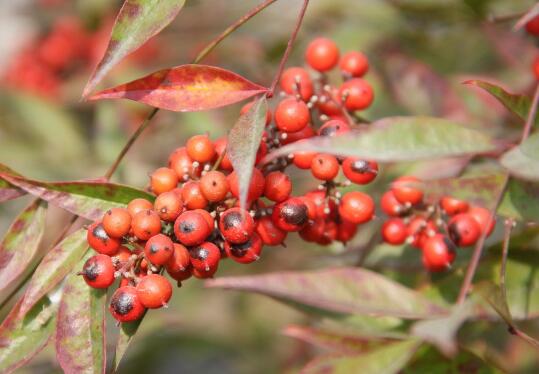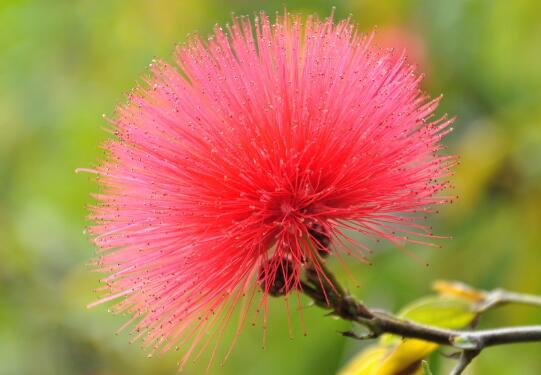Basil pest control methods, 4 pests 1 disease control/prevention is the key
Basil leaves are broad and wrinkled, although they are of high edible and medicinal value, they will also become the targets of diseases and insect pests, so when we plant them, we need to understand the prevention and control methods of basil diseases and insect pests in order to take the right control methods in time when basil worms or disease spots are present.
Control of diseases and insect pests of basil

Basil will give off fragrance, which will keep many pests from approaching, such as whitefly, etc., but some pests still feed on basil leaves, such as aphids, leaf miners, snails, thrips and so on.
1. Aphids
The main harm is basil leaves, stems, it will use mouthparts to pierce into the leaves to suck juice, the damaged leaves will appear withered, yellowing and other malnutrition symptoms, will greatly reduce the efficacy and effect of basil.
2. Leaf miner
The larvae of leaf miners will drill into the tissue of basil leaves and petioles and hide inside to eat mesophyll tissue, thus affecting the photosynthesis of the plant, resulting in irregular white stripes in the leaves, and the chlorophyll will gradually decompose and fall off.
3. Snails
In fact, the snail is also one of the pests that harm basil. It mainly feeds on the leaves of basil, which will cause the leaves to turn yellow and dull. They are very interested in buds and the juice of basil, and will cause the leaves to rot.
4. Thrips
There are many kinds of thrips, which feed on the sap of branches, leaves and flowers, mainly harming the tender leaves of basil, making the growth of the plant very slow, the leaves will become thinner after damage, and there will be grayish-brown stripes, which will affect the appearance.
Prevention and control measures: for the above-mentioned pests, the main means of prevention are to keep the environment ventilated, clean and hygienic, the temperature and humidity is not too high, watering does not accumulate water, and so on, while the treatment is mainly drug spraying, but also in accordance with the anti-insect net.
Basil leaf disease
Wilt disease is one of the diseases that do great harm to basil. At the initial stage, the leaves will lose water, and then there will be yellow markings, reticulate discoloration spots, and then the leaves will continue to fall off and cause the whole basil plant to die.
Prevention and control methods: before planting, disinfect the soil and keep the soil not too dry. If potassium fertilizer is applied at ordinary times, it can improve the resistance of basil to the pathogen of wilt disease and avoid wilting disease caused by lack of water and fertilizer.
Diseases and insect pests of basil and its control
Diseases of basil and its control
Basil suffers from diseases such as fungal wilt. When basil outbreaks fungal wilt, the pathogen invades from basil's vascular bundles, causing basil's plants to grow poorly and leaves to wither and wither. These pathogens can usually lie dormant in the soil for many years, and the prevention of diseases requires frequent soil change, or soil disinfection and sterilization to reduce the chances of disease outbreaks. In addition, if basil grows in an environment where air humidity is too high, poor ventilation, or poor soil drainage, it will also make germs and bacteria breed, appear a variety of diseases, and affect growth.
At ordinary times, we should pay attention to more ventilation to ensure that the soil does not accumulate water and minimize the chance of basil diseases. Don't use pesticides regularly. Basil is an edible and medicinal plant, there will be certain pesticide residues, will be harmful to the human body, the use of biological control or safe green control methods as far as possible.
Insect pests of basil and its control
In fact, basil is not suitable for the outbreak of insect pests, because basil itself has a special smell, which will drive some pests away from basil and avoid basil damage. However, basil can not avoid the harm of some pests.
Basil is sometimes harmed by pests such as aphids, burglars, thrips, Japanese beetles, snails, leaf miners and slugs. These pests will have more or less adverse effects on the growth of basil plants.
When these pests break out in basil, artificial or safe self-made pesticides are used to kill the pests. For example, install some insect-proof nets and use various materials to trap and kill pests. Reduce the use of pesticides and avoid pesticide pollution.
The planting method of basil
Basil is usually sown in mid-late April and can be broadcast live.
Floral organ selection
Basil is a kind of deep-rooted plant, whose roots can be buried in 0.5cm, so it is more suitable to choose a flowerpot with higher height.
Therefore, it is appropriate to choose well-drained, fertile and loose coconut soil for cultivation, and apply base fertilizer or nutritious soil before planting.
Methods of seed treatment:
Put the seeds in a container and first pour a little cold water to soak the seeds. After about 5 minutes, after soaking the seed skin and absorbing some water, slowly pour hot water into the container and stir it with a wooden stick to make the seeds heated evenly. When the water temperature in the container rises to 50 ℃ 55 ℃, you can stop heating water; when the temperature drops, add some hot water to keep the water temperature at the required temperature of 15 Murray for 20 minutes, then naturally cool to about 25 Mel, and continue to soak the seeds. The soaking time is based on the fact that the seeds are just saturated after water absorption. After basil soaking seeds, there is usually a layer of mucus on the seed surface, which is easy to mildew in the process of accelerating germination, resulting in rotten seeds. Therefore, after soaking the seeds, rinse the seeds repeatedly with clean water, and scrub them hard until the mucus on the surface of the seeds is removed, put the seeds into a gauze bag, shake off the water forcefully, cover them with wet towels or gauze, keep warm and moisturizing, and put them at a temperature of about 25 ℃ to accelerate germination.
In the process of sprouting, rinse with clean water once a day, control clean, such as a large amount of seeds, turn 1 Murray twice a day to balance the temperature and sprout neatly. The temperature in the early stage of budding can be slightly higher to promote sprouting, and when the bud is about to come out (the seed will open its mouth), start sowing.
Sowing should be carried out on a sunny day in the morning, put the nutritious soil into the sowing plate, pour it thoroughly with hot water or warm water, and so on, sprinkle a layer of soil, sow the sprouted seeds evenly on the plate, cover with 1cm thick soil, cover with plastic film, heat preservation and moisturizing.
Interplanting and replenishing seedlings were carried out when the seedling height was 6 cm and 10 cm. 2 seedlings were left in each hole, and 1 plant was left in strip sowing according to 10 cm. The topsoil was hoed 10-20 days after emergence for the first time. The second time is from early May to early June, before the seedlings are closed, and after each intertillage, nutritious soil should be applied. If you are afraid of drought in the seedling stage, you should pay attention to timely watering.
Pest control
In terms of insect pests, there are mainly aphids, Japanese beetles, thrips, leaf miners, snails and slugs. Organic cultivation can be used to spray away aphids and to catch Japanese beetles by hand and throw them into soapy water. Slugs and snails can be trapped in small beer containers or tied to copper at 5 cm (10 cm) from the base of the plant, which retreats due to the interaction between copper and slug mucus. In terms of diseases, sweet basil varieties were highly infected with fungal wilt (Fusarium oxysporum). The pathogen invades from the microtubule bundle of the root, hinders the growth of the plant and leads to leaf withering. Pathogens can lie dormant in the soil for many years. Fungus-resistant varieties of clove basil resistant to fungal wilt can be selected. In addition, high humidity and poor drainage are also more likely to be infected with fungal leaf spots. Basil mixed with asparagus, pepper, tomatoes and most vegetables can increase the growth and flavor of these crops, but not with cabbage and beans. In addition, stay away from Rutaceae. Because of its special taste, it can block whitefly and diamondback moth larvae. Slugs don't like basil either. Basil is also used as an insect repellent crop in organic cultivation in Taiwan to reduce insect pests.
Basil contains a special smell, which has a repellent effect on some pests, but some pests still gnaw on leaves, such as some varieties of basil, which would rather be scratched by hand at this time. Or use an anti-insect net to cover and isolate. Disease prevention is better than cure, the way is not to use the cultivated old soil to grow vanilla, because the hidden pathogens will become the source of infection, in addition, vanilla is cultivated in the right environment or season, so that the plant is strong and naturally resistant to the disease. Remember that fresh vanilla is eaten raw or heated for a short time. If it contains pesticides, it will have adverse effects on your health. Or use diluted detergent.
- Prev

What about the growing insects of Phyllostachys pubescens? pest control of Phyllostachys pubescens / 2 pests 2 diseases
In the process of cultivating Phyllostachys pubescens, the last thing we want to encounter is the problem of diseases and insect pests, which do great harm to the plant, and it is easy to make the plant die if we don't deal with it in time. So what about the bamboo worm in Nantian? How to control the diseases and insect pests of Phyllostachys pubescens? First, what to do with the growing insects of Phyllostachys pubescens
- Next

What about the growing insects of albizzia, pest control of albizzia flower / 3 insect pests 1 disease
The acacia flower is a kind of flower planted all over the world, which is highly ornamental, but if it is not careful in the breeding process, there will still be bad phenomena such as diseases and insect pests, which will affect the ornamental nature of the albizzia flower in its eyes. in serious cases, it will still lead to the phenomenon of wilting.
Related
- Fuxing push coffee new agricultural production and marketing class: lack of small-scale processing plants
- Jujube rice field leisure farm deep ploughing Yilan for five years to create a space for organic food and play
- Nongyu Farm-A trial of organic papaya for brave women with advanced technology
- Four points for attention in the prevention and control of diseases and insect pests of edible fungi
- How to add nutrient solution to Edible Fungi
- Is there any good way to control edible fungus mites?
- Open Inoculation Technology of Edible Fungi
- Is there any clever way to use fertilizer for edible fungus in winter?
- What agents are used to kill the pathogens of edible fungi in the mushroom shed?
- Rapid drying of Edible Fungi

